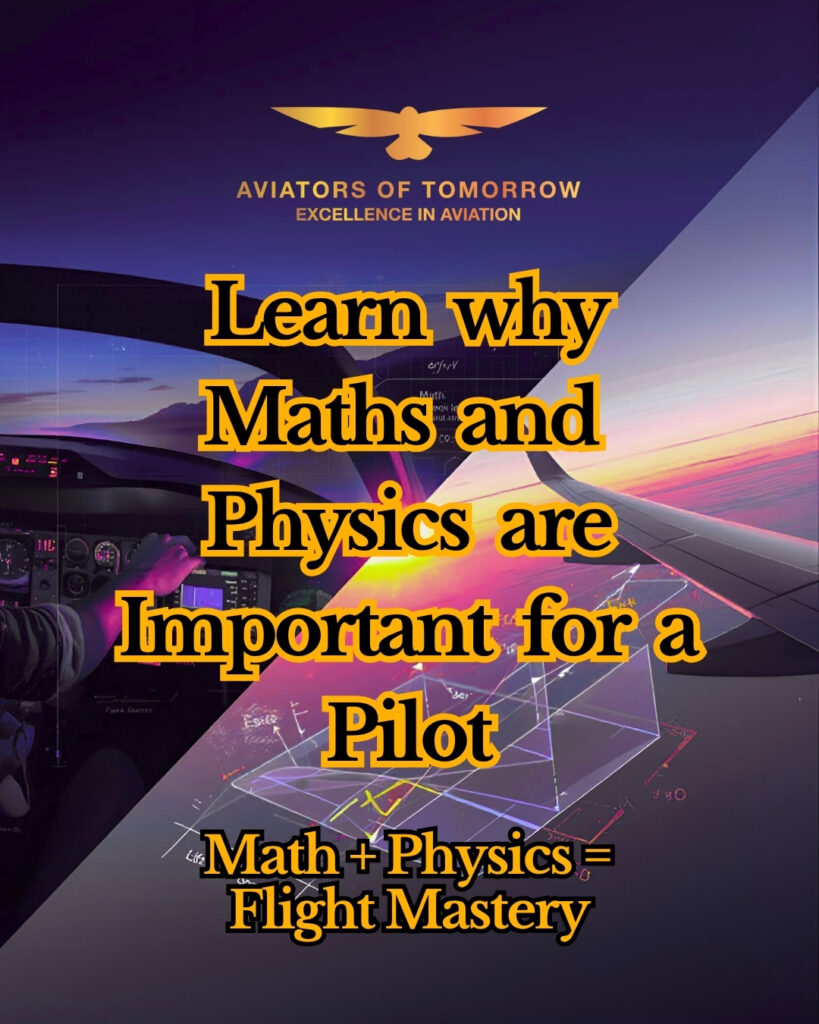When you imagine a pilot, the first things that come to mind are likely the uniform, the cockpit and the thrill of soaring through clouds. Rarely do we think about the invisible forces and numbers quietly guiding every flight. Yet, behind the glamour of aviation lies a world governed by physics and mathematics. These subjects are not just academic hurdles; they are the very tools that transform aspiring aviators into competent pilots who can command the skies safely and efficiently.
Whether you’re a student dreaming of your first solo flight or an enthusiast fascinated by aerodynamics, understanding why physics and mathematics are crucial for pilots will give you a new appreciation for both the aircraft and the mind that controls it.

🚀 Physics: The Language of Flight
Physics is, in essence, the study of how the universe works. In aviation, it’s the key to understanding how planes fly, how they maneuver and how they respond to the environment. Here’s why physics is indispensable for aviators:
1. Lift, Drag, Thrust and Weight
Every aircraft you see in the sky is a practical demonstration of Newtonian physics. Lift counters gravity, drag resists motion, thrust propels the plane forward and weight tugs it down. A pilot must understand how these forces interact to maintain controlled flight. For example, miscalculating lift during takeoff or landing can result in disastrous consequences. Physics gives pilots the ability to anticipate and respond to these forces effectively.
2. Aerodynamics and Maneuvers
Turns, climbs and descents aren’t just instinctive; they follow precise physical principles. The way air flows over the wings, the angle of attack and even the effect of turbulence can only be understood with a solid grasp of physics. Knowledge of aerodynamics helps pilots execute smoother, safer and more fuel-efficient maneuvers.
3. Weather Interpretation
Understanding weather isn’t just about reading forecasts. Pilots interpret atmospheric conditions, cloud formations and wind patterns using physics principles. For instance, turbulence can be predicted by knowing how air masses move and thermals can affect lift during glider or small aircraft flights. Physics turns weather from a mysterious force into a predictable factor that pilots can account for.
4. Navigation and Instruments
Modern cockpits are filled with instruments that provide crucial data airspeed, altitude, vertical speed and heading. All of these rely on physics: pitot tubes measure air pressure to calculate speed, gyroscopes determine orientation and altimeters measure changes in air pressure to gauge altitude. Without understanding the physics behind these tools, pilots cannot interpret or trust their instruments effectively.
📐 Mathematics: The Pilot’s Secret Weapon
While physics explains the forces at play, mathematics is the tool pilots use to quantify, predict and plan their flights. Numbers aren’t just for engineers; they are the lifeline for anyone who wants to command an aircraft safely.
1. Flight Planning and Fuel Calculations
Before every flight, pilots calculate fuel requirements, weight distribution and range. These calculations involve algebra, ratios and percentages. Overestimating fuel can be costly; underestimating it can be dangerous. Mathematics ensures that every flight is balanced, safe and efficient.
2. Navigation and Coordinates
Global aviation relies on precise navigation. Pilots use trigonometry to calculate headings, distances and wind corrections. Even with GPS technology, understanding the underlying math allows pilots to cross-check positions and plan alternate routes. Mathematics gives pilots the confidence to navigate both routine and emergency situations with accuracy.
3. Performance Analysis
Aircraft performance varies depending on altitude, temperature and weight. Pilots use mathematical formulas to determine takeoff and landing distances, climb rates and optimal cruising speeds. A miscalculation here isn’t just inconvenient; it can be life-threatening. By understanding these formulas, pilots can make informed decisions in real time.
4. Emergency Situations
Emergencies demand quick, precise thinking. Whether it’s calculating the glide distance with engine failure or determining the effect of wind on a diverted landing, mathematics allows pilots to make fast, reliable decisions. In high-pressure situations, mental math often becomes a pilot’s silent co-pilot.
✈️ What If You Didn’t Have Physics and Math in Class 12?
Not having Physics and Mathematics in your 12th grade doesn’t mean you have to give up on your dream of becoming a pilot. Many students face this situation and there’s a clear solution that keeps your aviation goals on track. You can still become eligible for pilot training by completing these subjects through the National Institute of Open Schooling (NIOS) or any other recognised open board. This option allows you to study and pass Physics and Mathematics even after completing Class 12, without redoing the entire school year.
Here’s what you can do:
- ✅ Enroll with NIOS (or another recognised board) for Physics and Mathematics as additional subjects.
- ✅ After passing these exams, your qualification becomes equivalent to 10+2 with Physics and Math, which meets DGCA requirements for pilot training.
- ✅ Once eligible, you can start DGCA Ground Classes, followed by flight training at an approved Flying Academy.
Remember, it’s never too late to begin. Many successful pilots started their journey through this exact route. With focus, consistency and a strong passion for aviation, you can bridge the academic gap and confidently take your first steps toward the cockpit.
You may read our blog “DGCA Ground Classes vs Flight Training“
🛩️ Bridging Theory and Practice
For many students, physics and mathematics can feel abstract and distant from the dream of flying. However, in aviation, these subjects are highly practical. Here’s how aspiring pilots can bridge the gap:
- Simulations and Flight Labs: Flight simulators let students see physics in action. From stall recovery to crosswind landings, every maneuver reinforces the principles learned in the classroom.
- Hands-On Calculations: Instead of memorising formulas, students can apply them in flight planning exercises. Calculating fuel, weight distribution and glide paths makes math tangible and directly relevant.
- Weather Observations: Tracking local weather and noting its effects on flight performance helps students connect physics principles with real-world experience.
The goal is to make numbers and forces more than theoretical; they become trusted allies in every flight decision.
🌟 The Mindset of a Pilot: Analytical and Precise
Beyond practical calculations, mastering physics and mathematics shapes the mindset required for safe aviation. Pilots must think logically, anticipate outcomes and respond quickly. Studying these subjects fosters:
- Analytical Thinking: Evaluating multiple factors before taking action.
- Problem-Solving Skills: Adjusting plans based on changing conditions.
- Attention to Detail: Every decimal in speed, fuel, or heading can matter.
These cognitive skills translate directly into safer, smarter piloting.
✨ Conclusion
Flying isn’t just about sitting in a cockpit and pressing buttons; it’s a delicate dance between science, numbers and skill. Physics and mathematics are not optional for pilots; they are essential instruments in the invisible toolkit that ensures every flight is safe, efficient and successful.
For aspiring aviators, embracing these subjects early isn’t just about passing exams; it’s about building a foundation that will support a lifetime in the skies. Understanding forces, performing calculations and thinking analytically transforms a dream of flight into a disciplined, confident reality.
In short, every soaring aircraft is powered not just by engines and fuel, but by the timeless principles of physics and the precision of mathematics. The next time you watch a plane ascend gracefully into the clouds, remember: it’s not just the pilot’s skill at work, it’s a symphony of numbers and forces, harmonised by the mind that understands them.

